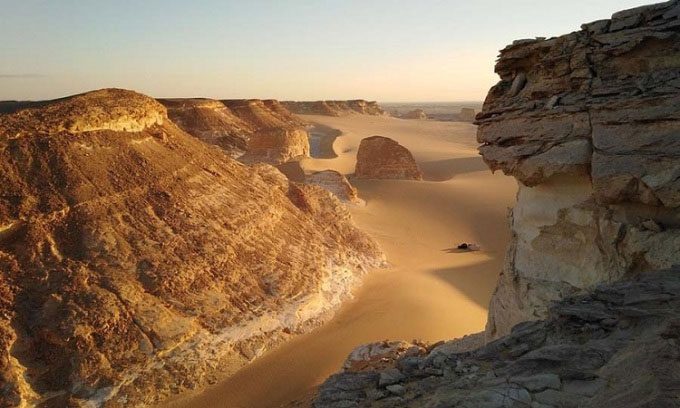In 1957, scientists proposed the idea and calculated that it would require the detonation of 213 nuclear bombs to flood the Qattara Depression, creating an inland sea.
The Sahara Desert is a vast region covering an area of 9.2 million km2 in northern Africa. Historically, there have been numerous plans to flood parts of the Sahara Desert, as many areas of this sandy desert lie below sea level, according to IFL Science.

The Qattara Depression of the Sahara lies below sea level. (Photo: Egypt Nile)
The first to initiate the idea was Scottish engineer Donald McKenzie. He aimed to flood the El Djouf basin, transforming it into the Sahara Sea. McKenzie proposed creating a 644 km long canal from Morocco to the basin, thereby forming an inland sea the size of Ireland (96,560 km2). Similarly, in the 1870s, inspired by the Suez Canal, Captain François-Elie Roudaire of the French army suggested building a 193 km canal to connect the Mediterranean Sea with the saline Chott el Fejej area of the Sahara Desert in southern Tunisia, which would flood 4,828 km2 of sandy land.
This idea received support from Ferdinand de Lesseps, a famous French diplomat known for overseeing the construction of the Suez Canal. The estimated cost to realize this plan at that time was around 25 million francs (4.2 million USD). The plan aimed to open up additional trade routes for French shipping. De Lesseps and his associates envisioned transforming North Africa into a wetter and more fertile region. However, exploratory missions discovered that the area did not actually lie below sea level, and rising costs prevented the ambitious plan from ever becoming a reality. Despite its failure, the concept inspired author Jules Verne to reference the construction of a canal in his 1905 novel *Invasion of the Sea*, where an earthquake contributes to the creation of an inland sea in northern Africa.
Another plan to bring the sea into the Sahara was proposed in Egypt. The Plowshare Project was an initiative of the U.S. Atomic Energy Commission. Researchers calculated that it would require the detonation of 213 nuclear bombs to create a canal that would flood the Qattara Depression, which is 60 meters below sea level. However, various international agreements prohibited nuclear bomb detonations, leading to the termination of the Plowshare Project in 1977.
More recently, in 2018, a Silicon Valley company named Y Combinator introduced an idea to combat global warming by flooding the Algodones Desert area in California. Their plan was to create millions of water reservoirs covering 0.4 hectares to cultivate algae, serving as carbon sinks. However, with an estimated cost of around 50 trillion USD, this project has yet to be advanced.





















































